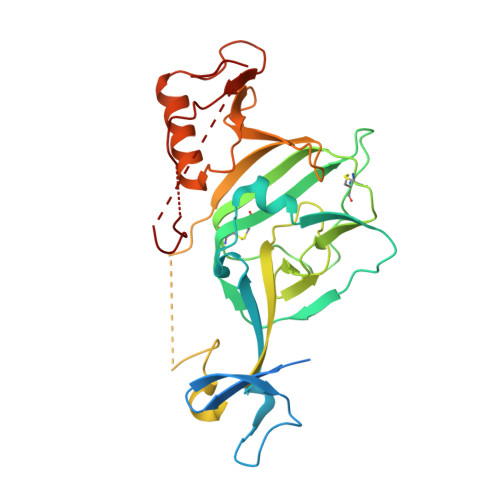Single-component multilayered self-assembling nanoparticles presenting rationally designed glycoprotein trimers as Ebola virus vaccines.
He, L., Chaudhary, A., Lin, X., Sou, C., Alkutkar, T., Kumar, S., Ngo, T., Kosviner, E., Ozorowski, G., Stanfield, R.L., Ward, A.B., Wilson, I.A., Zhu, J.(2021) Nat Commun 12: 2633-2633
- PubMed: 33976149
- DOI: https://doi.org/10.1038/s41467-021-22867-w
- Primary Citation of Related Structures:
7JPH, 7JPI - PubMed Abstract:
Ebola virus (EBOV) glycoprotein (GP) can be recognized by neutralizing antibodies (NAbs) and is the main target for vaccine design. Here, we first investigate the contribution of the stalk and heptad repeat 1-C (HR1 C ) regions to GP metastability. Specific stalk and HR1 C modifications in a mucin-deleted form (GPΔmuc) increase trimer yield, whereas alterations of HR1 C exert a more complex effect on thermostability. Crystal structures are determined to validate two rationally designed GPΔmuc trimers in their unliganded state. We then display a modified GPΔmuc trimer on reengineered protein nanoparticles that encapsulate a layer of locking domains (LD) and a cluster of helper T-cell epitopes. In mice and rabbits, GP trimers and nanoparticles elicit cross-ebolavirus NAbs, as well as non-NAbs that enhance pseudovirus infection. Repertoire sequencing reveals quantitative profiles of vaccine-induced B-cell responses. This study demonstrates a promising vaccine strategy for filoviruses, such as EBOV, based on GP stabilization and nanoparticle display.
Organizational Affiliation:
Department of Integrative Structural and Computational Biology, The Scripps Research Institute, La Jolla, CA, USA.




















